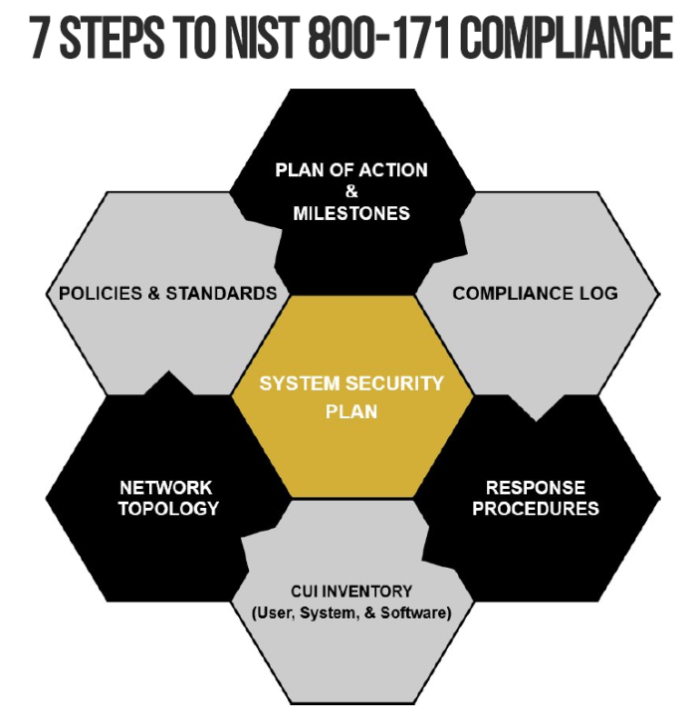Data security is a critical concern for organizations handling sensitive information, especially for contractors working with the Department of Defense (DoD). The National Institute of Standards and Technology (NIST) Special Publication 800-171 provides a comprehensive framework to protect Controlled Unclassified Information (CUI). Implementing these controls is essential for achieving Cybersecurity Maturity Model Certification (CMMC) and ensuring robust data security. This blog explores the importance of implementing NIST 800-171 controls for data security and how it supports compliance and protection.
Understanding NIST 800-171
NIST 800-171 outlines 110 security requirements across 14 families, addressing various aspects of cybersecurity. These families include access control, awareness and training, audit and accountability, configuration management, and more. The primary goal of these controls is to safeguard CUI in non-federal systems, ensuring that sensitive information remains protected from unauthorized access and cyber threats.
Enhancing Cybersecurity Posture
Implementing NIST 800-171 controls significantly enhances an organization’s cybersecurity posture. By following these guidelines, organizations can establish a comprehensive security framework that addresses potential vulnerabilities and threats. This proactive approach helps prevent data breaches, protects sensitive information, and ensures the integrity and confidentiality of CUI.
Access Control
Access control is a fundamental aspect of NIST 800-171. It involves establishing policies and procedures to manage who can access specific information and systems. Implementing multi-factor authentication, regular access reviews, and strict user permissions are essential practices. These measures ensure that only authorized personnel have access to sensitive data, reducing the risk of unauthorized access and potential data breaches.
Incident Response
Developing a robust incident response plan is crucial for managing and mitigating the impact of cybersecurity incidents. NIST 800-171 emphasizes the importance of having procedures in place for detecting, reporting, and responding to incidents. Regularly testing these procedures and training employees on their roles in incident response ensures that organizations can swiftly and effectively address security breaches, minimizing damage and recovery time.
Configuration Management
Proper configuration management helps maintain the security and integrity of information systems. NIST 800-171 requires organizations to establish baseline configurations, manage changes systematically, and monitor systems for unauthorized changes. By adhering to these practices, organizations can ensure that their systems are configured securely and remain protected against potential threats.
Supporting CMMC Requirements
Achieving NIST 800-171 compliance is a critical step towards meeting CMMC requirements. The CMMC framework incorporates many of the controls outlined in NIST 800-171, particularly at levels 2 and 3. By implementing these controls, organizations can demonstrate their commitment to cybersecurity and readiness for CMMC assessments. This alignment not only helps in securing DoD contracts but also enhances overall data security.
Audit and Accountability
Audit and accountability are essential components of both NIST 800-171 and CMMC requirements. Implementing logging and monitoring systems enables organizations to track user activities and detect suspicious behavior. Regular audits ensure that security controls are functioning correctly and compliance is maintained. These practices are crucial for identifying potential security incidents and ensuring accountability within the organization.
Awareness and Training
NIST 800-171 emphasizes the importance of cybersecurity awareness and training for all employees. Ensuring that staff are knowledgeable about security policies, potential threats, and their roles in protecting CUI is vital. Regular training sessions and awareness programs help create a security-conscious culture within the organization, supporting both NIST 800-171 compliance and overall data security.
Reducing Risk and Liability
Implementing NIST 800-171 controls helps organizations reduce their risk and liability. By adhering to these guidelines, organizations can minimize the likelihood of data breaches and the associated costs. Compliance with NIST 800-171 also demonstrates a commitment to cybersecurity, which can enhance trust with clients and partners. This proactive approach to risk management is essential for maintaining a strong security posture and protecting valuable assets.
Media Protection
Media protection involves safeguarding both digital and physical media that contain sensitive information. NIST 800-171 requires organizations to implement measures such as encryption, secure storage, and proper disposal of media. These practices ensure that CUI remains protected throughout its lifecycle, preventing unauthorized access and data loss.
Physical Protection
Physical protection controls are designed to secure the physical environment where information systems and data are stored. NIST 800-171 mandates measures such as access controls, surveillance, and environmental protections. By implementing these controls, organizations can prevent physical tampering, theft, and damage to critical assets.
Facilitating Continuous Improvement
Implementing NIST 800-171 controls fosters a culture of continuous improvement in cybersecurity. Regularly reviewing and updating security practices ensures that organizations stay ahead of evolving threats and maintain compliance with current standards. This commitment to continuous improvement helps organizations enhance their cybersecurity posture over time, supporting long-term data security and resilience.
Risk Assessment
Risk assessment is a critical component of NIST 800-171. Organizations must regularly assess their security risks and vulnerabilities to ensure that appropriate controls are in place. Conducting thorough risk assessments helps identify potential weaknesses and prioritize remediation efforts, enhancing overall data security.
System and Information Integrity
Ensuring system and information integrity involves implementing measures to protect against unauthorized access and modifications. NIST 800-171 requires organizations to use tools such as antivirus software, intrusion detection systems, and regular patch management. These practices help maintain the integrity of information systems and protect against cyber threats.
Conclusion
Implementing NIST 800-171 controls is essential for enhancing data security and achieving compliance with CMMC requirements. By adopting these guidelines, organizations can protect sensitive information, reduce risks, and demonstrate their commitment to cybersecurity. This proactive approach not only supports regulatory compliance but also strengthens the overall security posture of organizations handling CUI. Through continuous improvement and adherence to best practices, organizations can ensure the integrity and confidentiality of their data, safeguarding their operations and reputation in the process.



